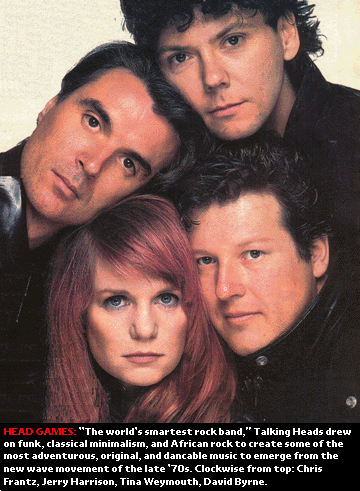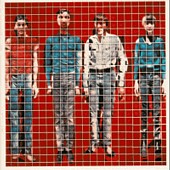|
Talking Heads Sire 1032 Dec. 1978 Billboard: #26
It was the pub scene, long forgotten by the press and music critics, that maintained the sweaty immediacy and sense of intimacy that are so important for live music to work. In England, places like the Hope and Anchor Pub helped launch the careers of such pre-punk acts as Graham Parker, Ian Dury, and Nick Lowe (with Brinsley Schwarz) and also provided the spawning ground for the future punk rockers. In America, New York's CBGB (the now ironic acronym for "Country, Bluegrass, and Blues") served as a home base to bands like Television, the Patti Smith Group, Blondie, and the Ramones, and the Talking Heads. Each of these acts had little in common musically, but they cohabited well and a scene developed that grew large enough to attract attention. It wasn't long before CBGB came to be viewed as a musical mecca, and virtually every band that was part of the scene eventually released a record. If everybody who now claims to have been part of the New York club scene from the beginning really was there, then the Bowery would have sunk into the ocean from the weight of all the bodies, and CBGB's walls would have burst. In reality, punk was fringe culture that never really caught on, expanded only by a few curious onlookers who would drop in to gawk at what they perceived to be a freak show. CBGB held only about four or five hundred sweat-soaked and illegally crammed people. Practically none of the original punk-rock bands who played there sold records in sufficient enough quantities to chart, and for the most part, the scene remained insular. It wasn't until punk was softened into the much more easily digestible and readily packaged new wave that it began to make a commercial dent in the U.S. By blunting the razor's edge of punk's safety-pin-and-spray-paint leer, and replacing it with the cool angularity of Day-Glo geometric shapes and skinny ties, the record companies were able to turn punk into a fashion statement, and the American public finally succumbed. Only by virtue of the fact that it never really went away, punk has remained highly influential in determining the direction of the recent music that has been disturbed by its wake.
Byrne's genuine image might seem to be a contradiction of punk's attitude, but it was actually perfect for the punk rock scene. An important part of the punk ethic was to disregard what was expected of you. If standard corporate posturing was offensive or unnatural, then you ought to stick to your guns and be true to yourself. Once you did so, the sense of freedom would be immediate, and the stylistic impact both overwhelming and palpable. Because Byrne's style was different, it was also perceived to be genuine and spontaneous. Without excess deliberation, he was therefore able to recapture the rebellious essence of good rock and roll. Artistry and integrity had become an anomaly in late '70s rock and roll, but the Talking Heads reintroduced them as primary ingredients to be incorporated over primal (but intelligent and tasteful) rhythms. "Take Me to the River" broadsided the status quo by combining the best ingredients of conventional pop music and classic soul music, stirring them together, and then presenting the mix in the guise of punk rock. The first ingenious thing the Talking Heads did was to take a classic soul song and slow it down. Even more important was choosing Al Green (as much of a trailblazer of hearfelt soul as ever existed, yet not sanctified to the point where a cover version would appear sacrilegious) as the source of inspiration. Then they worked on it until it felt comfortable, so comfortable that it was interchangeable with their own original songs. By the time they finished, they achieved what previously would have been considered all but impossible. They took an Al Green song, recreated it in their own image, but never destroyed the funky root. They usurped Green's song right from under him. Through their work with Brian Eno (three albums' worth), the Talking Heads almost single-handedly come to represent the East Coast perspective of new wave rock and roll. It was a heady responsibility, but Byrne's aloof demeanor diffused whatever weighty maxims were being thrust at him. Meanwhile, bandmembers Chris Frantz and Tina Weymouth, the husband-and-wife rhythm section, began work on a commercially successful side project called the Tom Tom Club, which recorded more relaxed compositions than the deliberately cranial work of the Talking Heads. In 1983, director Jonathan Demme documented a Talking Heads concert in a film called Stop Making Sense, which, in tandem with the Band and Martin Scorcese's The Last Waltz, stands out as the most professionally made and entertaining rock-and-roll film ever. Video conscious in the video age, the Talking Heads increased their relevance throughout the '80s, until they suspended their recording as a group in favor of individual interests. - Thomas Ryan, American Hit Radio, Prima Entertainment, 1996.
kat Would love to know who did the strip tease in the 1978 videodorant of Take Me To The River ? Thanks!!! |


